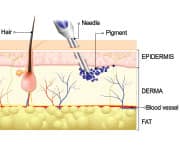Life Extension Magazine®
The numbers of people getting tattoos have markedly increased starting more than 20 years ago.

Roughly 38% of people ages 18-29 now have at least one tattoo.1
Most are unaware of the risks, from infection to exposure to heavy metals, to being unable to detect an early skin cancer.
The inks used in tattoos contain pigments that are often derived from heavy metals.
There is concern that these toxins could raise the risk of cancer, DNA damage, inflammation, oxidative stress, and weakening immune function.
Tattoos remain popular, but they are not without consequential health risks.
Toxic Ink in Tattoos

The moment a tattoo artist gets to work, risks arise. People can have allergic reactions to skin dyes or develop a skin infection from the wound.2
In May 2019, the U.S. Food & Drug Administration (FDA) issued a safety advisory, warning that tattoo ink could be contaminated with microorganisms, which can cause infections and scarring.3
The long-term effects are potentially more serious.
To make designs, a tattoo artist injects ink into the dermis, the second layer of skin.4
Some of the pigments used may be derived from toxic heavy metals, including mercury, lead, nickel, and cadmium.5 Some of these have been classified as human carcinogens by the International Agency for Research on Cancer and the U.S. Environmental Protection Agency.6
Other pigments are similar to clothing and leather dyes called azo pigments. Many of these have been shown to be carcinogenic or genotoxic (damaging to DNA).7
These substances can eventually enter the bloodstream.8
Spreading Throughout the Body
There are two main ways the potentially toxic ink from tattoos can be carried throughout the body:
- The incisions made by the tattoo needle cause the immune system to send cells called macrophages to the area to help close the wound and destroy foreign invaders. These macrophages can transport larger ink particles to the lymph nodes, glands that filter harmful substances.4
- Tiny ink particles called nanoparticles can penetrate through the skin layers and enter the bloodstream.8 Carbon black, the most common ink used in tattoos, is most often associated with higher levels of nanoparticles.9
In one study, researchers tattooed the backs of mice. Within 42 days, 32% of the ink from the tattoo had been leached away from the tattoo site.10
A 2017 analysis found potentially toxic dyes and metals in the lymph nodes of deceased individuals who had had tattoos.4
The lymph nodes are a vital part of the immune system. A build-up of toxic particles there may weaken immunity, hurting the body’s ability to ward off infections and illnesses of all kinds.11
Potential Risk of Cancer
Recent studies have shown that metal nanoparticles have the potential to cause DNA damage.
A 2019 study of breast cancer cells in animal models showed that exposure to these nanoparticles led to accelerated tumor growth and a greatly increased ability for cancer to metastasize (spread).12
A 2018 review of the medical literature found at least 64 reported cases of tattoo-associated skin cancer in humans.13
Increased Inflammation
It has been determined in preclinical studies that ink nanoparticles have the ability to cause chronic inflammation.14
Inflammation has been associated with increased risk for type II diabetes, heart disease, strokes, arthritis, Alzheimer’s disease and other forms of dementia, and many other illnesses.
The presence of tattoo ink nanoparticles in the skin, lymphatic system, and liver could potentially contribute to increased oxidative stress, production of pro-inflammatory cytokines, and cell death in all these areas.
A review study presented data on nanoparticle ingestion by inhalation, which was associated with many potential health problems in addition to cancer, including:15
- Alzheimer’s and Parkinson’s disease,
- Asthma, bronchitis, and emphysema,
- High blood pressure and blood clots,
- Heart disease,
- Diseases of the kidneys and liver,
- Crohn’s disease (a chronic inflammatory bowel disease), and
- Autoimmune disorders.
Exposure to toxins has also been associated with an increase in senescent cells and shortening of telomeres.
Both of these effects are associated with a shortened lifespan and increased disease risk.
Tattoo Removal

Removing a tattoo is usually done by laser. It involves breaking up ink pigments into a smaller size, so they can more easily migrate away from the skin.
It has been suggested that in the short term, this process could increase the amount of metal nano-particles in the bloodstream, lymph nodes, and liver. Tattoo removal also does further damage to the skin.
Over the next decade, we can expect to see the development of many more rapid tattoo removal techniques.16 This may convince people to see tattoos as a temporary decision and get them more frequently.
The harmful impact of a tattoo may be permanent, though. Each time one is applied and then removed, damage to the skin increases, as does exposure to potential toxins.
What you need to know
The Risks of Getting Tattooed
- The popularity of tattoos has been growing for years, especially among young adults.
- Several risks are well known, including skin infections from the wound or infections and scarring from contaminated needles.
- A neglected potential danger is the ink used for tattoo designs. They are often derived from toxic heavy metals, including mercury and lead, or dyes called azo pigments. Many of these are known carcinogens.
- Tiny ink particles can enter the bloodstream and lymphatic system, potentially even migrating to the liver. This in turn could potentially increase the risk of certain types of cancer.
- Getting a tattoo removed may not undo the damage.
- Though long-term research into the dangers of tattoos needs to be done, their potential to cause harm may have been overlooked
Conclusion

Little conclusive research has been done into the health effects of tattoos. But some of the inks tattoo artists use are derived from toxic heavy metals and dyes.
These substances have been found to damage DNA and to be carcinogenic.
Tiny nanoparticles from the ink can enter the bloodstream and spread to the lymphatic system and the liver.
They may increase the risk of some cancers and contribute to dangerous chronic inflammation, oxidative stress, and weakening of immune function.
While you or someone you know may be considering getting a tattoo, this is not a decision that should be made lightly, given the potential health risks.

Gavin Logan is a longtime supporter who resides in New Zealand. He authored this article and donated it to Life Extension® Magazine so that it could be widely disseminated.
References
- Available at: https://www.mdedge.com/pediatrics/article/214634/adolescent-medicine/adolescents-should-know-risks-tattoos-and-piercings. Accessed December 10, 2020.
- Available at: https://www.mayoclinic.org/healthy-lifestyle/adult-health/in-depth/tattoos-and-piercings/art-20045067. Accessed December 10, 2020.
- Available at: https://www.fda.gov/cosmetics/cosmetics-recalls-alerts/fda-advises-consumers-tattoo-artists-and-retailers-avoid-using-or-selling-certain-tattoo-inks. Accessed December 11, 2020.
- Schreiver I, Hesse B, Seim C, et al. Synchrotron-based nu-XRF mapping and mu-FTIR microscopy enable to look into the fate and effects of tattoo pigments in human skin. Sci Rep. 2017 Sep 12;7(1):11395.
- Available at: https://www.scientificamerican.com/article/tattoo-ink-mercury-and-other-toxins/. Accessed December 15, 2020.
- Tchounwou PB, Yedjou CG, Patlolla AK, et al. Heavy metal toxicity and the environment. Exp Suppl. 2012;101:133-64.
- Moller P, Wallin H. Genotoxic hazards of azo pigments and other colorants related to 1-phenylazo-2-hydroxynaphthalene. Mutat Res. 2000 Jan;462(1):13-30.
- Sepehri M, Sejersen T, Qvortrup K, et al. Tattoo Pigments Are Observed in the Kupffer Cells of the Liver Indicating Blood-Borne Distribution of Tattoo Ink. Dermatology. 2017;233(1):86-93.
- Jacobsen NR, Clausen PA. Carbon black nanoparticles and other problematic constituents of black ink and their potential to harm tattooed humans. Curr Probl Dermatol. 2015;48:170-5.
- Engel E, Vasold R, Santarelli F, et al. Tattooing of skin results in transportation and light-induced decomposition of tattoo pigments--a first quantification in vivo using a mouse model. Exp Dermatol. 2010 Jan;19(1):54-60.
- Available at: https://www.ndtv.com/food/here-s-how-getting-tattoos-may-put-your-immune-system-in-danger-1749661. Accessed December 11, 2020.
- Peng F, Setyawati MI, Tee JK, et al. Nanoparticles promote in vivo breast cancer cell intravasation and extravasation by inducing endothelial leakiness. Nat Nanotechnol. 2019 Mar;14(3):279-86.
- Paprottka FJ, Krezdorn N, Narwan M, et al. Trendy Tattoos-Maybe a Serious Health Risk? Aesthetic Plast Surg. 2018 Feb;42(1):310-21.
- Foerster M, Schreiver I, Luch A, et al. Tattoo inks and cancer. Cancer Epidemiol. 2020 Apr;65:101655.
- Buzea C, Pacheco, II, Robbie K. Nanomaterials and nanoparticles: sources and toxicity. Biointerphases. 2007 Dec;2(4):MR17-71.
- Available at: https://www.soliton.com/. Accessed December 11, 2020.

